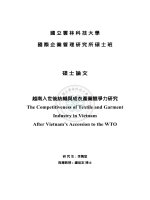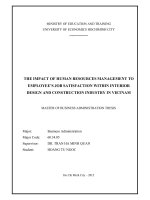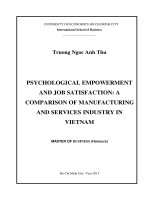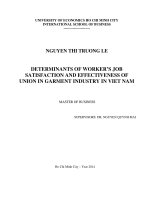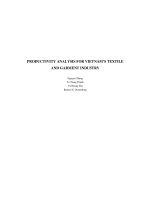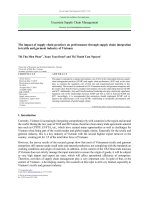THE POTENTIAL OF RADIOFREQUENCYIDENTIFICATION APPLICATION ON TEXTILE AND GARMENT INDUSTRY IN VIETNAM
Bạn đang xem bản rút gọn của tài liệu. Xem và tải ngay bản đầy đủ của tài liệu tại đây (877.59 KB, 93 trang )
FOREIGN TRADE UNIVERSITY
FACULTY OF BUSINESS ADMINISTRATION
MAJOR: INTERNATIONAL BUSINESS MANAGEMENT
GRADUATION THESIS
Thesis title:
THE POTENTIAL OF RADIO-FREQUENCY-
IDENTIFICATION APPLICATION ON TEXTILE
AND GARMENT INDUSTRY IN VIETNAM
Student name : Lê Thị Thanh Hải
Class : A2 - High quality class
Intake : K46 - QTKD
Supervisor : MA. Nguyễn Thị Khánh Chi
Hanoi, May 2011
TABLE OF CONTENT
Lastly, RFID can help improve stocking. In traditional retail locations, it is
often difficult to predict when an item will sell out. During a holiday rush, for
instance, retail employees may be busy serving customers and left without
adequate time to count the number of products on hand. A delay in knowing
when a product is coming close to selling out creates long wait times for
customers, who may be disappointed that an item is not available and bring
their business to a competitor 20
Such a system was extremely inefficient and time consuming for both
employees and human resources, and the scope for errors and fraud remained
huge. The advantage of this system lay in its simplicity and its non-dependence
on unstable technology such as computers and power supply. This method as
such retains its relevance when the workplace is small and confined to a single
location, and where the entry and exit are closely monitored to prevent swipe
fraud 65
Computer-Based Attendance Tracking: The development of technology and
the proliferation of computers have brought in better ways of tracking
employee attendance compared to the traditional time sheet methods. These
systems are ether web based or application based and invariably entail use of a
computer. The most basic of such systems includes logging in with name and
password or scanning a barcode on the employee ID card. But using such
systems, it is impossible to eliminate fraud from the employee’s side 65
i
LIST OF ABBREVIATIONS
RFID : Radio-frequency-identification
UPC : Uniform Code Council
IATA : International Transport Association
EPC : Electronic product code
ID : Identification
AFTA : ASEAN Free Trade Agreement
ASEAN : Association of Southeast Asia Nations
CAD : Computer Aided Design
CAM : Computer Aided Manufacturing
EU : European Union
US : United States
VINATEX : Vietnam Textile and Garment Cooperation
VINATAS : Vietnam National Textile and Apparel Association
WTO : World Trade Organization
DC : Distribution center
ERP : Enterprise resource planning
AD : Avery Dennison
POS : Point of sale
JSC : Joint Stock company
MFN : most- favoured- nation
AFF : Asia Fashion Federation
IT : Information technology
AFTA : ASEAN Free Trade Area
APEC : Asia-Pacific Economic Cooperation
IMF : International Monetary Fund
ii
LIST OF FIGURES AND TABLES
Lastly, RFID can help improve stocking. In traditional retail locations, it is
often difficult to predict when an item will sell out. During a holiday rush, for
instance, retail employees may be busy serving customers and left without
adequate time to count the number of products on hand. A delay in knowing
when a product is coming close to selling out creates long wait times for
customers, who may be disappointed that an item is not available and bring
their business to a competitor 20
Such a system was extremely inefficient and time consuming for both
employees and human resources, and the scope for errors and fraud remained
huge. The advantage of this system lay in its simplicity and its non-dependence
on unstable technology such as computers and power supply. This method as
such retains its relevance when the workplace is small and confined to a single
location, and where the entry and exit are closely monitored to prevent swipe
fraud 65
Computer-Based Attendance Tracking: The development of technology and
the proliferation of computers have brought in better ways of tracking
employee attendance compared to the traditional time sheet methods. These
systems are ether web based or application based and invariably entail use of a
computer. The most basic of such systems includes logging in with name and
password or scanning a barcode on the employee ID card. But using such
systems, it is impossible to eliminate fraud from the employee’s side 65
iii
INTRODUCTION
1. Background of the study
Nowadays, technology advances quickly so that firms are compelled to catch
up with the latest technological developments. In order to protect their
competitiveness, they should timely accomplished investments in technology.
Ecommerce solutions proposed have drawn the attention of many companies to
deploy. One of the technologies offering a solution is Radio Frequency
Identification (RFID). RFID is one of the best tools not only for the implementation
of a tracking solution but also for the strategic purpose of ensuring a competitive
advantage. RFID technology is currently considered a hot topic in the IT arena and
has been described as a major enabling technology for automated, contactless,
wireless data collection. This is a technology that has been in use in different areas
especially in the textile and garment industry where competition and cost reduction
is paramount issue.
In the mean time, Vietnam’s textile and garment industry has developed
rapidly in recent years and become a vital activity within the country’s economy.
Globalization brings to Vietnam many new opportunities, including textile and
garment industry. Garment companies will chance to expand the markets in USA
and other markets. However, the competitiveness of the Vietnamese garment and
textile is still poor in the process of integration in the region and the world. Low
efficiency in production-line, lack of modern specializing machines and investment
in new technology led to low productivity in comparison with other countries. To
reverse this situation, the Vietnam’s apparel industry need to take considerable
efforts to upgrade technology in the manufacturing process.
RFID is a technology where the goal is to identify goods automatically with as
little human intervention as possible. This is one of the emerging technologies that
have been increasingly used in textile and garment industry in recent years. It offers
solutions in production management, so that garment firm can benefit from automatic
control, improve productivity based on real-time information. Despite that, RFID
technology seems to be new concept to textile and garment enterprises in Vietnam.
1
2. Objectives of the study
The world economy is recovering, but is expected to still have many
unpredictable risks, so Vietnam garment and textile enterprises will have to
continue to protect their competitive advantage, actively welcome business
opportunities the crisis may offer. To achieve the goal of sustainable growth, textile
and Vietnam will focus attention to develop infrastructure, innovate technique.
This study, therefore, examines the potential of RFID’s deployment on
textile and garment manufacturing in Vietnam.
The objectives are:
• To give an overall picture of what Radio Frequency Identification (RFID)
is about, how it works and the potential applications on business.
• To review and analyze the situation of textile and apparel industry in Vietnam
through assessment manufacturing processing of the textile and clothing industry.
• To evaluate the ability of RFID implementation in apparel manufacturing
in Vietnam.
• To describe how companies in this industry use RFID for conducting
business.
• To recommend solutions so as to boost up textile and garment industry in
Vietnam.
3. Research questions
The thesis “The potential of RFID application on textile manufacturing in
Vietnam” is answer to four most concentrated questions:
Main research question
Is RFID a utilizing solution to enhance manufacturing situation of Vietnam’s textile
and garment firms?
Sub-question 1:
What is Radio Frequency Identification technology? And why is it important in
business operation?
Sub-question 2:
2
What are the strong points and problematic issues lying in Vietnam’s textile and
garment manufacturing activities?
Sub-question 3:
How are RFID technology being implemented in the textile and garment industry
and to what extend do it act on Vietnam’s apparel manufacturing?
Sub-question 4:
What are benefits RFID technology contribute to enhancing profitability at
Vietnam‘s textile and garment enterprises?
Sub-question 5:
What are other solutions to lift up Vietnam‘s textile and garment industry?
4.Methodology
4.1 Problem recognition
The purpose of this study is to give an analysis of ability RIFD application
on apparel manufacturing in Vietnam. To achieve the target of this study, a variety
of research methodology was used.
According to Saunders Lewis (2003, third edition, p25), research
methodology is an approach that is adopted for research and it is based on research
philosophy and the nature of the subject under investigation. Therefore, an
appropriate research method will have positive impacts on the reliability and
practicability of the study.
4.2 Research design
Types of research
The research would utilize both descriptive and exploratory research
methods in the conduct of the study. Descriptive research is a method used to obtain
information relating to the current status of an issue or phenomenon to describe
"what exists" within the variables or conditions of the situation. Exploratory
research, on the other hand, is often utilized in order to yield information to explain
problems which are not yet clearly defined or the real scope is still unclear.
This present study is an exploratory attempt since it would try to gather
information regarding the effects of technology, RFID in specific, on the textile and
3
garment manufacturing in Vietnam. The researcher makes use of existing literature
in order to verify my observations and come up with preliminary ideas regarding
the research problem.
Types of data
One research study will lose its objectiveness if the research’s results base on
no data. Such study will be deemed to be personal idea and not recognized for any
findings. The researchers, therefore, must determine if the information needed is
currently available from existing sources – secondary data or if new research must
be conducted – primary data.
In this study, both two types of data are gathered in order to support for the
discussion and assessment of the manufacturing apparel activities. A two-stage
methodological approach was adopted. The first involved a multi-case study of
apparel companies adopted RFID in the world. Some in-depth interviews were
conducted with manager to analyze situation of garment firms in Vietnam. The
second involved the design of a framework with propositions for examining the
values generated for fashion enterprise upon the RFID implementation.
4.3 Data collection
Secondary data
There are different data gathering procedures that the researcher uses for
this term paper. In this study, the information gathered in this thesis is mainly based
on the Secondary data which collected through internet from web site, business
magazine, books and news paper, financial statement.
In addition, the study uses data from other sources like Vietnam Export
Portal, Vietnam Financial Review, Vinatex’s website( Vietnam National Textile
and Garment Group) to gain valuable data to examine the situation of Vietnam’s
apparel industry.
Primary data
In order to get the quantitative data, personal interviews are carried out.
Those interviews with few simple questions do not take more than two or three
minutes or they will be interrupted from their works. The researcher had an
4
interesting interview with the director of Thanhcong textile garment Investment
Trading Joint Stock Company to ask about Internet services usage in company.
Those interviews with few simple questions do not take more than two or three
minutes or they will be interrupted from their works.
5 Structure of the study
Besides the index, list of abbreviations, preface, summary, list of references
and appendices, the thesis dissertation is composed of three parts:
Chapter 1: this chapter provides a literature review of RFID technology and
gives an insight into the applications of RFID. The analysis presented in this chapter
is based on qualitative studies providing business cases for RFID deployments.
Chapter 2 analyses the situation of textile and garment manufacturing in
Vietnam. From there, evaluation limitations existed in supply chain management of
textile and garment industry in Vietnam is identified.
Chapter 3 is devoted to some empirical findings and recommendations about
RFID adoption in textile and garment manufacturing in Vietnam.
5
CHAPTER I
LITERATURE REVIEW OF RFID TECHNOLOGY
AND RFID APPLICATION
Radio frequency identification (RFID) technology, in itself, is not a new
idea. Radio technology was first used, as early as during World War II by the
British, to identify their own planes, from those of the Germans. This was one of the
first known applications of RFID. Since that time, the capabilities of Radio
Frequency Identification have expanded exponentially.
In this chapter, the technology of RFID is going to be presented sufficiently,
so as to have an overall picture of what Radio Frequency Identification is about,
how it works and which are the potential benefits and drawbacks.
I. Overview of RFID technology
1.1. Definitions
RFID stands for Radio-Frequency Identification. It is an automatic
identification technology whereby digital data that is encoded in an RFID tag or
"smart label" is captured by a reader using radio waves
1
.
RFID is similar to bar code technology but it uses radio waves to capture
data from tags, rather than optically scanning the bar codes on a label. RFID does
not require the tag or label to be seen to read its stored data which is a key factor of
an RFID system.
1
English word information ( wordinfo.info/ unit/3994/ip)- Radio Frequency Identification
6
1.2 Components
A typical RFID system consists of four main components: tags, an encoder,
reader, and a host computer.
Figure 1: Tag RFID
A tag, also called transponder, is
made up of a microchip with a coiled
antenna. Tags are the heart of an RFID
system, because they store the information
that describes the object being tracked. The
main function of an RFID tag is to transmit
data to the system's other parts. Specific
object information is stored in the memory
of tags and is accessed via the radio signal of
RFID readers.
Source: Robert A. Kleist and partners
(2004),p17
An encoder is used to write information to the tag. An RFID encoder is used
in conjunction with a barcode print and applies system. The RFID encoder utilizes
information obtained from a data stream from a host computer, from a
corresponding barcode label, or other source to program an RFID label. The
programmed label can then be applied with an integrated applicator or an external
applicator.
Figure 2: RFID encoder Source: Robert A. Kleist and partners (2004),p18
7
Figure 3: RFID reader
A reader, also called interrogator,
is comprised of a transmitter, receiver,
control module and a transceiver. An
RFID tag reader uses antennas to
communicate with the RFID chip. Reader
requirements vary depending on the type
of task and application, and almost all
applications will require multiple forms of
readers to make a successful system.
Source: www.doowa-rfid.com
A host computer: The reader decodes the data encoded in the tag's integrated
circuit (silicon chip) and the data is passed to the host computer for processing. It’s
the system element responsible to record and manage the information resulted by
tag reading. It’s a computerized machine that communicates (by wireless) with
RFID reader and stores what is registered in the RFID tag.
Figure 4: Main components of an RFID system
Source: AutoID ( />1.3. RFID systems characteristics
Almost everything that you buy from retailers has a UPC bar code printed on
it. These bar codes help manufacturers and retailers keep track of inventory. They
8
also give valuable information about the quantity of products being bought and, to
some extent, by whom the products are being bought. These codes serve as product
fingerprints made of machine-readable parallel bars that store binary code. In fact,
Bar codes have been around since the last thirty years or so, during which time, they
have been used for automatic identification of goods, auto parts, sports tickets,
airline baggage and a myriad of other things. So what’s the problem now? Why do
we need a better technology?
Figure 5: Barcode from bottle of Sprite
Source: />Well, the reasons are several. One, bar code scanners need a “ line of sight”.
This means that a bar code scanner has to clearly “see” the bar code. Else it cannot
read it. This also implies that faded or damaged bar codes cannot be read. You must
have experienced this sometimes, again in supermarkets or other stores where the
clerk has to scan an item once again, because it didn’t get ready by the scanner the
first time.
Secondly, barcodes can code only limited amount of data. For example, it
can tell the store manager, that a breakfast cereal box has been sold, but it cannot
say, which particular box was sold.
RFID tags are an improvement over bar codes because the tags have read and
write capabilities. Data stored on RFID tags can be changed, updated and locked.
Some stores that have begun using RFID tags have found that the technology offers
a better way to track merchandise for stocking and marketing purposes. Through
9
RFID tags, stores can see how quickly the products leave the shelves and who's
buying them.
Conceptually, bar coding and RFID are quite similar; both are intended to
provide rapid and reliable item identification and tracking capabilities. The primary
difference between the two technologies is that bar coding scans a printed label with
optical laser or imaging technology, while RFID scans, or interrogates, a tag using
radio frequency signals. So, the RFID technology has many main features as
following:
- Read method: This is not required for RFID tags for the most part, and
items can be oriented in many different directions. As long as the tag is in the
reader’s read range, it can be read without direct line of sight. With bar codes, line
of sight is definitely required, as a scanner must physically “see” each item directly,
and items must be oriented in a very specific manner.
- Read distance: RFID tags can be read at much greater distances; an RFID
reader can pull information from a tag at distances up to 300 feet. Whereas, the
range to read a barcode is much less, typically no more than fifteen feet.
- Read speed: RFID tags can be read far more rapidly than a bar code label,
at theoretical rates up to 500 per second, while Barcode readers usually take a half-
second or more to successfully complete a read.
- Durability: RFID tags are much better protected, and can even be
internally attached to an asset since line of sight is not required. Therefore, they can
be read and used in much harsher environments. Bar codes have much lower
durability, and can be easily damaged or removed. Additionally, bar codes are
virtually impossible to read once they are dirty or greasy.
- Read/Write capability: With RFID tags, the ability to read, write, modify,
and update data is possible. With bar code labels, only reading is possible.
- Security: Extremely high security is possible with RFID tags, and data
can be encrypted, password protected, or set to include a “kill” feature to remove
data permanently if necessary. Bar codes have much lower levels of security, and
can be more easily reproduced or counterfeited.
10
1.4. Role of RFID technology
RFID has been called the first important technology of the 21
st
century and
has become one of the most talked-about technologies in business today. With the
development of RFID standards, RFID technology plays an important role in a wide
range of applications in different fields of business.
1.4.1. Improving product quality and work quality
When having the existence of RFID, human errors can be avoided in
production processes. When processes history can be controlled by writing
information to an inspection data Tag. By controlling the quality-related
information (model type, features, etc) in the Tag, optimal control of each product
can be achieved, and products can be exchanged or replaced in mid-process.
1.4.2. Increased yields, shorter lead times, greater flexibility
Production line changes can be dramatically speeded up by reading the
model data in the Tag and automatically changing processes. By designing the
production line in a series of modules, functions can be expanded or changed by
adding or exchanging module units. By writing data to the inspection data Tag,
adjustments can be quickly processed.
1.4.3 Lower costs, Less inventory
It is possible to reduce costs for losses or mistakes due to human errors
( mis-reading characters from a sheet of paper, mistakes made when writing
information elsewhere, etc. Storing model data onto Tags makes it possible to
respond to the diversification of product needs.
1.4.4. Good effects on environment
Information management by Tag memory can help to achieve paperless
operations. Tags with read/ write capacity are used, so a system can be introduced
without generating new waste materials. The RFID system lets us add functions in
module units to your present system, making it easy to utilize existing assets.
11
II. RFID applications
In recent years we have seen an increase in the use of RFID, mainly due to
three key factors: tag price reduction, high performance reliability and international
consensus regarding frequency use. There is a wide variety of RFID applications
implemented in various sectors. The use of RFID systems makes it possible to
provide instant inventory management, increase asset visibility, prevent theft, track
shipments, recall products and support interoperability in an end-to-end integrated
environment.
2.1. RFID application in public
2.1.1. RFID toll road payment
The transportation industry is one of the leading users of RFID technology
because they have identified numerous applications. RFID applications in
transportation include railroad car management, traffic management, tolls and fees,
fare collection, equipment identification, fleet management, solid waste hauling,
and fuel dispensing.
RFID is used to automatically identify the account holder and make faster
transactions. When the car moves through the toll gate on any road, it is indicated
on the RFID reader that it has crossed the clearing. The need for manual toll based
systems is completely reduced in this methods and the tolling system works through
RFID. The system thus installed is quite expedient reducing the time and cost of
travelers since the tag can be deciphered from a distance. This application helps to
keep good traffic flow and to identify traffic patterns using data mining techniques
that can inform the administration or decision support systems.
2.1.2. RFID in baggage handling management
For the airline industry, getting passengers to their destinations on time and
with their accompanying luggage is a feat that requires identifying and tracking
millions of items daily. The rates of mishandling at airports have been growing in
the last few years. Handling large amount of packages from many places to various
destinations on different routes can be very complex.
12
RFID implementation and experiences are being widely sponsored at
government level. Amsterdam Schiphol Airport is the first large scale attempt to
introduce RFID baggage control in Europe, before the end of 2007. Other trials of
RFID tagging in Europe are being made in London Heathrow and Paris Charles de
Gaulle. Also, at Hong Kong Int. Airport, RFID baggage tagging has been
implemented and is fully functional since 2005, with decision to upgrade by
Intermec to Gen 2RFID. Bag-tag read success rates of around 85-90% were
improved to above 95%, with estimated cost savings of US$3.8 million
2
.
RFID tags could be used to track and identify airline luggage and passengers
increasing national security, speeding up luggage sorting and transfer, and
decreasing expenditures resulting from heightened security measures. The major
advantages of RF technology in baggage handling are an increased journey speed of
luggage as a result of faster read rates and elimination of human intervention in
misdirected bags and security procedures. The International Air Transport
Association (IATA) believes this technology has countless potential benefits for
simplifying passenger travel for airports and airlines.
2.1.3. RFID applications in hospital
Keeping track of patients, equipment, and pharmaceutical products is a very
important function in an institution as hospital. RFID applications in the healthcare
industry are focused on patient safety, medical facilities management.
Healthcare providers traditionally use a paper-based ‘flow chart’ to capture
patient information during registration time, which is updated by the on duty nurse
and handed over to the incoming staff at the end of each shift. Although, the nurses
spent large amount of time on updating the paperwork at the bedside of the patient,
it is not always accurate, because this is handwritten.
To solving that, hospitals use RFID tags for transmitting and receiving data
from a patient to health service without human intervention. It is an automated data-
capture technology that can be used to identify, track, and store patient information
contained on RFID wristband, resembling a watch with a passive RFID chip in it.
2
An AeroAssist white paper June 2008- RFID in aviation
13
This chip stores a unique patient ID number and some relevant medical information
such as the patient's blood type, age, location, in order to speed treatment. Patient
databases can also be linked through Internet into other hospitals databases. To
ensure patient privacy and to avoid medical records are improperly disclosed,
medical data are not stored on the devices but are rather stored in a secure database
that links the unique patient's ID with its data. It will be mainly very useful in
mental care hospitals where doctors can track each and every activity of the patient.
Hospitals also use these RFID tags for locating and tracking all the activities of the
newly born babies. RFID technology has great potential in healthcare, to increase
revenue through improved patient throughput, improve patient satisfaction through
reduced wait times, enhance quality of care, staff efficiency and productivity
Likewise, in the medical equipment field, RFID-product tags can be used to
track and locate medical devices. The use of RFID on medical equipment enables
hospital staff to rapidly locate critical medical devices. This enhances patient safety,
and can reduce the risk of theft equipment in hospital. Additionally these tags can
be used to inventory equipment and consumables used in an operation, including
scalpels, sponges, clamps and other surgical equipment. At the end of an operation
everything can be automatically accounted for. Finally, applying RFID help reduce
overhead and minimizing duplicate supplies of critical inventory.
2.1.4. RFID application in library
A library is a collection of information, sources, resources, books, and
services. Libraries have materials arranged in a specified order. According to a
library classification system, items may be located quickly and collections may be
browsed efficiently. Imagine a library in which no book would ever be misplaced or
stolen. RFID is a technology that makes it all possible.
Library experience with Bar code is still in its early stages. But barcodes
have some disadvantages when taking an inventory of the library. The need to have
a direct line of sight on the barcode makes it difficult, however, to perform
functions on more than one item at a time. Because each book must be tipped out
far enough to read the barcode if it is on an outside cover, or removed entirely from
the shelf if the book or item must be opened to see the barcode.
14
To improve library management effective, RFID library system is used.
RFID library systems consist of an integrated circuit and an antenna, which
enables it to function as a transponder. It can be attached to any item with the
information about the item stored in it. Each item attached with an RFID tag
instead of bar codes. So, what are differences? For one, the tags can
communicate at a distance with the store clerk’s handheld RFID reader. They
can communicate almost all at once, so there is no need for her to painstakingly
scan each item. Secondly, the amount of data on each RFID tag is massive, as
compared to the data that was stored on the bar codes. This can be seen on the
PC screen. Lastly, the numbers of persons that are needed to do this work are
less. That means that RFID library system reduces queues and increases the
number of customers using self-check, which in turn will reduce the staff
necessary at the circulation desks. A person can locate RFID library books
marked with a RFID tags, using the RFID reader which identifies and locates the
book. When the book is carried to the counter, the library staff can either activate
or deactivate the electronic article surveillance bit in the book's tag. If a book is
borrowed, then the surveillance bit is deactivated.
The use of RFID reduces the amount of time required to perform circulation
operations. The most significant time savings are attributable to the facts that
information can be read from RFID tags much faster than from barcodes and that
several items in a stack can be read at the same time. A unique advantage of RFID
systems is their ability to scan books on the shelves without tipping them out or
removing them. A hand-held inventory reader can be moved rapidly across a shelf
of books to read all of the unique identification information. Using wireless
technology, it is possible not only to update the inventory, but also to identify items
which are out of proper order.
2.2. RFID application in private
2.2.1. Supply chain management
Today, the largest RFID application aids companies and governments in
supply chain management. RFID is being used to manage products through
production, distribution and retail.
15
A simple Supply Chain consists of end-customers or consumers who buy
goods or services from a retailer at a store or through other channels, such as an e-
commerce website. The manufacturer buys raw materials from suppliers. The
distributor normally buys goods in large quantities from a manufacturer who makes
the goods in a factory or a production facility. The retailer may stock the goods and
tools to provide the services from a wholesaler or a distributor.
Figure 6. A simple retail supply chain
Source: Laudon and partners( 2004, p54)
In supply chain management, RFID tags are used to track products
throughout the supply chain from supplier delivery, to warehouse stock and point of
sale. A RFID reader can “scan” the container and load the received inventory
directly into the company database. The company database can further break down
where each item is to be delivered inside the plant or warehouse also greatly
reducing time and cost to stock or deliver the assets internally. RFID provides the
technology to identify uniquely each container, pallet, case and item being
manufactured, shipped and sold, thus providing the building blocks for increased
visibility throughout the supply chain. By adding RFID tags to every product, tool,
resource and item of materials handling equipment, manufacturers will be able to
get better demand signals from customers and the market.
RFID promises to revolutionize supply chains and usher in a new era of cost
savings, efficiency and business intelligence. The potential applications are vast as
it is relevant to any organization engaged in the production, movement or sale of
physical goods. This includes retailers, distributors, logistics service providers,
16
manufacturers and their entire supplier base, hospitals and pharmaceuticals
companies, and the entire food chain.
RFID will have a significant impact on every facet of supply chain
management—from the simple tasks, such as moving goods through loading docks,
to the complex, such as managing terabytes of data as information about goods on
hand is collected in real time. It has a potential to dramatically improve supply
chain by reducing costs, inventory levels, lead times, stock outs and shrinkage rates;
increasing throughput, quality, manufacturing flexibility, inventory visibility,
inventory record accuracy, order accuracy, customer service, and the collaboration
among supply chain members.
In the very near future, the adoption of sensor-based RFID technology will
allow the creation of the real-time, sensor-connected manufacturing plant.
2.2.2 Manufacturing
The case for manufacturing efficiency has never been more important than it
is today. Manufacturers are faced with globalization, increased competition and
other economic pressures and increase asset utilization and reduce material costs,
while at the same time address customers who are demanding faster delivery, better
customer service and customized products. Today’s manufacturers are looking to
RFID to address many of these challenges.
Firstly, for shop floor applications such as work in process (WIP), RFID-
tagged raw material and sub-assembly parts are routed and tracked throughout work
stations along the assembly line and the entire production process. RFID automates
the validation of sequence and components and speeds build times. Customization
requirements can be built into the system and validated immediately, eliminating
costly reworks. RFID can track the history of the production and finished goods,
important information for shipping and possible recalls.
Secondly, for finished goods shipping out the back door, RFID tags on out-
going pallets and containers contain vast amounts of information including
contents, product history, origin and destination points, order information and
handling instructions. RFID can track ‘pedigree’ information where the product is,
17
where it has been, who accepted it and at what stage. It reduces shipping delays by
increasing staging accuracy and ensuring the right shipment is on the right outbound
truck. RFID allows you to “certify” the shipment. Establishing agreements with
trading partners to leverage RFID data as “proof of delivery” can speed the
processing of transactions and and significantly reduce claims or returns.
Last but not least, RFID is helpful tool for asset management solution. Any
item that is a part of the work process but does not leave as part of a finished
product is a candidate for intelligent asset management with RFID. RFID can help
enterprises automatically track and secure these assets with very little human
intervention. To track assets with RFID, tags are attached to all assets from servers,
racks, and laptops to office chairs, carts, and kegs. To take inventory, an employee
can simply roam the facility with a handheld RFID reader or a mobile RFID reader
on a cart — there’s no need to properly identify the asset, locate a bar code, and
scan each asset one by one. Without the intensive labor, companies can afford to
replace the annual audit with weekly or even more frequent inventory counts. And
RFID’s automation eliminates the costly errors associated with manual inventory,
including missed or mis-categorized assets. The result is an up-to-date accurate
picture of asset status as frequently as needed to best manage the business.
To sum up, RFID solutions can ultimately help manufacturers reduce
operating costs by reducing labor costs, claims and returns, thereby increasing
operating income. And working capital can be reduced by enabling reductions in
inventory and lowering inventory write-offs from unsaleables and returns. RFID
minimizes human errors and time-consuming steps in the process, increases
inventory accuracy and provides real-time information for managers to make
accurate decisions.
2.2.4 Retail
Retail sector is one of the most important business sectors which see
potential in the use of RFID technology in order to stay at a competitive edge and to
achieve profitability in short or long terms. In the retail industry RFID technology is
expected to replace the barcode technology as it provides much more functionalities
18
without requiring the line of sight of the reader thus ensuring speed and process
efficiency. So, what does RFID offer retail?
Retailers face the constant demand to have the right goods available at the
right places in the right quantities. First and foremost, incorporating RFID
technology into existing supply chain operations can reduce the labor required to
monitor goods movement and inventory flow. Bar code-based tracking systems are
an effective tool for basic inventory tracking. Used in conjunction with a bar code
system or as a stand-alone inventory tracking application, RFID allows
manufacturers and retailers to complement existing systems while gathering more
information throughout a supply chain. Systems with the power to update the
information that moves with an individual product provide complete supply chain
visibility without the prohibitive labor costs and error rates a similar manual system
would entail.
For manufacturing, RFID also can act like a security guard at a gateway. As
goods are moved from dock to truck to store, RFID can conduct automatic
inventories and compare the goods with the manifest. Goods flow becomes more
complete, stock outs are reduced, overages are curtailed and accounting
discrepancies are removed.
RFID tracking systems are finding their way into cross-dock and
warehousing applications first. But as they stretch further throughout a retail supply
chain, they will require close cooperation between suppliers and retailers. As RFID
systems are adopted, manufacturers will tag goods during production so everyone
along the way, from supplier to manufacturer to logistics teams and end customers,
benefits from the increased information that RFID systems provide.
A growing number of retailers are beginning to see RFID as a tool not only
for improved product visibility, but also for preventing product theft—or, at least,
for reducing the negative impacts of product shrinkage. The benefits from RFID
adoption is shown as following:
Firstly, in a retail marketing environment, RFID technology can help
dramatically reduce the amount of theft. This, in turn, saves companies money and
19
allows for lower retail prices. RFID chips embedded in products allow retailers to
track them. This allows distributors and retails to receive alerts when a product is
lost and enables them to take immediate action to stop the loss. For example, if an
expensive computer system includes RFID, you can notify security personnel
electronically if the product leaves a present area without payment.
Secondly, RFID technology helps to lower overhead in a business, allowing the
company to operate more efficiently. Before a retailer sells a product, it must go
through several different steps, including being shipped and stored. With RFID,
retailers can track incoming shipments at each of these stages. For instance, retailers
can locate a pallet containing multiple products within a large storage warehouse.
Traditionally, locating and tracking shipments took place manually. Replacing this time
consuming manual process with RFID helps to lower labor costs and increase savings.
Using RFID also allows a retail company to know precisely how many units
of inventory it has on hand. Again, this is a time-consuming task that typically takes
place manually. RFID allows a manager to check the current inventory of a status
with a simple glance at a computer. Lower labor costs and less time spent counting
inventory translates in higher profits and lower prices.
Moreover, RFID allows retailers to streamline the checkout process. Because
retailers can electronically track products within a retail location, they can scan
multiple items and pay for them at once. A shopper with a cart full of different
products, for example, can check out and pay for the items as a group, instead of
waiting for someone to scan them one at a time.
The advantages of RFID checkout apply to both retailers and consumers. For
customers, RFID technology reduces wasted time spent waiting in checkout lines
and streamlines the payment process. For store owners, this electronic checkout
helps to lower labor costs.
Lastly, RFID can help improve stocking. In traditional retail locations, it is
often difficult to predict when an item will sell out. During a holiday rush, for
instance, retail employees may be busy serving customers and left without adequate
time to count the number of products on hand. A delay in knowing when a product
20


